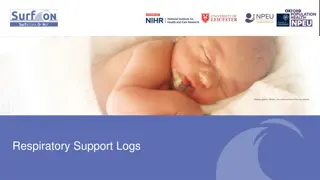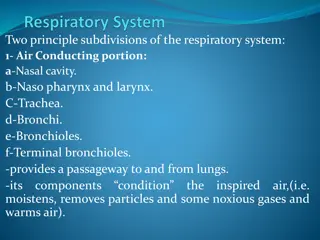Medical Eligibility Criteria for Circulatory and Respiratory Diseases in CCS Outreach Presentation
This presentation outlines the medical eligibility criteria for circulatory and respiratory diseases under the California Children's Services (CCS) program. It covers conditions such as diseases of the circulatory system including endocardium, myocardium, and more, as well as respiratory conditions like chronic lung disease of infancy. Specific criteria for inclusion based on various conditions are detailed, including Kawasaki disease and chronic pulmonary infections. The presentation aims to guide healthcare providers in determining eligibility for services under CCS for patients with these medical conditions.
Download Presentation

Please find below an Image/Link to download the presentation.
The content on the website is provided AS IS for your information and personal use only. It may not be sold, licensed, or shared on other websites without obtaining consent from the author.If you encounter any issues during the download, it is possible that the publisher has removed the file from their server.
You are allowed to download the files provided on this website for personal or commercial use, subject to the condition that they are used lawfully. All files are the property of their respective owners.
The content on the website is provided AS IS for your information and personal use only. It may not be sold, licensed, or shared on other websites without obtaining consent from the author.
E N D
Presentation Transcript
CCS Outreach Presentation: CCS Medical Eligibility Section III: Circulatory System to Accidents, and NICU Criteria Last update: 08.2016 by LA County CCS Department of Public Health
Section III: Dr. Sunthorn Sumethasorn Assistant Medical Director Topics: Sections: Circulatory System to Accidents, and NICU Criteria 1
41518.2. Diseases of the Circulatory System (a) Diseases of the endocardium, myocardium, or pericardium; (b) Cardiac dysrhythmias requiring medical or surgical intervention; (c) Diseases of blood vessels such as embolism, thrombosis, aneurysms, and periarteritis; (d) Cerebral and subarachnoid hemorrhage; (e) Chronic diseases of the lymphatic system; (f) Primary hypertension that requires medication to control; or (g) Congenital anomalies of the circulatory system that meet the criteria of section 41518.8. 2
Kawasaki Disease KEY POINT Numbered letter 10-0501 Fever 5 days or more 4 of the following: Bilateral conjunctival injection Generalized rash Oral mucosal changes Peripheral extremity changes Cervical lymphadenopathy Other known disease processes are excluded. 3
41518.3. Diseases of the Respiratory System (a) Chronic pulmonary infections such as abscess or bronchiectasis; (b) Cystic fibrosis; 4
41518.3. Diseases of the Respiratory System (c) Chronic Lung Disease (CLD) of infancy, such as Bronchopulmonary Dysplasia (BPD), when either (1) or (2) below is met: (1) History of care in a neonatal intensive care unit that includes all of the following: (A) Mechanical ventilation for more than six days; (B) Concentration of oxygen greater than 60 percent for more than four of the days of ventilation; and (C) Need for supplemental oxygen for more than 30 days; or 5
41518.3. Diseases of the Respiratory System (2) The presence in an infant of at least one of the following: (a) Radiographic changes characteristicof CLD such as areas of hyperinflation, areas of radiolucency, and areas of radio density due to peribronchial thickening or patchy atelectasis; (b) Impaired pulmonary function, as manifested by one or more of the following during a stable phase: increased airway resistance, increased residual capacity, decreased dynamic compliance, arterial CO2 tension (PaCO2) greater than 45 or arterial O2 tension (PaO2) less than 80; or (c) Cardiovascular sequelae such as pulmonary or systemic hypertension or right or left ventricular hypertrophy. 6
41518.3. Diseases of the Respiratory System (d) Asthma, when it has produced chronic lung disease; (e) Chronic disorders of the lung that are the result of chemical injury, metabolic disorders, genetic defects, or immunologic disorders other than asthma; (f) Respiratory failure requiring ventilatory assistance; (g) Hyaline membrane disease; or (h) Congenital anomalies of the respiratory system that meet the criteria of section 41518.8. 7
Respiratory System KEY POINTS: CF-related metabolic syndrome (CRMS) is not eligible. Respiratory failure Ventilatory assistance could be non-invasive or invasive 8
41518.4. Diseases of the Digestive System (a) Diseases of the liver including: (1) Acute liver failure; (2) Chronic liver disease; 9
41518.4. Diseases of the Digestive System (b) Disorders of the gastrointestinal tract including: (1) Chronic inflammatory diseases requiring complex ongoing medical management or surgical intervention such as pancreatitis, peptic ulcer, ulcerative colitis, regional enteritis, diverticulitis, and cholecystitis; (2) Chronic intestinal failure; or (3) Gastroesophageal reflux when: (A) It is part of or complicates the management of a CCS-eligible condition; or (B) It is an isolated condition with complications such as esophageal stricture or chronic aspiration pneumonia. 10
41518.4. Diseases of the Digestive System (c) Congenital anomalies of the digestive system that meet the criteria of section 41518.8. 11
Digestive System Examples of eligible conditions Inflammatory bowel disease Cholelithiasis associated with chronic hemolytic disease Hepatitis C with evidence of chronic liver disease Non-eligible conditions Irritable bowel syndrome Diet controlled celiac disease Acute cholecystitis Acute pancreatitis Hepatitis C without evidence of chronic liver disease 12
Digestive System KEY POINT CHRONIC INTESTINAL FAILURE Directive by State CMS Chief Medical Officer. Is eligible when the child has required TOTALparental nutrition without enteral nutritional intake (oral or tube) for 28 or more days in a 12 month period. 28 days do not need to be consecutive 13
41518.5. Diseases of the Genitourinary System (a) Acute glomerulonephritis in the presence of acute renal failure, malignant hypertension, or congestive heart failure; (b) Chronic glomerulonephritis, chronic nephrosis, or chronic nephrotic syndrome; (c) Chronic renal insufficiency; (d) Obstructive uropathies; (e) Vesicoureteral reflux, grade II or greater; (f) Renal calculus; or (g) Congenital anomalies of the genitourinary tract that meet the criteria of section 41518.8. 14
41518.6. Diseases of the Skin and Subcutaneous Tissues (a) Persistent or progressive diseases of the skin or subcutaneous tissue, such as pemphigus and epidermolysis bullosa, which; (1) Are disabling or life-threatening; and (2) Require multidisciplinary management; 15
41518.6. Diseases of the Skin and Subcutaneous Tissues (b) Scars when surgery is required and at least one of the following criteria is met: (1) There is limitation of or loss of mobility of a major joint, such as the ankle, knee, hip, wrist, elbow, or shoulder; or (2) They are disabling or severely disfiguring. (c) Congenital anomalies of the skin or subcutaneous tissue that meet the criteria of section 41518.8. 16
41518.7. Diseases of the Musculoskeletal System and Connective Tissue (a) (1) Acute and chronic suppurative infections of the joint; (2) Chronic, progressive or recurrent inflammatory disease of the connective tissue or joints, such as rheumatoid arthritis, inflammatory polyarthropathy, lupus erythematosus, dermatomyositis, and scleroderma; (3) Chronic, progressive, or degenerative diseases of muscles and fascia, such as myasthenias, myotonias, dystrophies, and atrophies that lead to atrophy, weakness, contracture and deformity, and motor disability; 17
41518.7. Diseases of the Musculoskeletal System and Connective Tissue (4) Intervertebral disc herniation; (5) Scoliosis with a curvature of 20 degrees or greater; (6) Other disease of the bones and joints, except fractures, resulting in limitation of normal function and requiring surgery, complex customized bracing, or more than two castings; or (7) Congenital anomalies of the musculoskeletal system or connective tissue that meet the criteria of section 41518.8. 18
41518.7. Diseases of the Musculoskeletal System and Connective Tissue (b) Minor orthopedic conditions, such as tibia torsion, femoral anteversion, knock knees, pigeon toes, and flat feet, which only require special shoes, splints, and/or simple bracing are NOT eligible. 19
Musculoskeletal System and Connective Tissue KEY POINTS Not all Rheumatologic conditions are CCS eligible. Kyphosis is not the same as scoliosis. Decreased athletic performance is not the same as limitation of normal function 20
Musculoskeletal System and Connective Tissue Examples of non-eligible Disc protrusion or bulge Pectus deformity (unlikely to limit normal functions) 21
41518.8. Congenital Anomalies (a) CCS applicants with congenital anomalies shall be medically eligible for participation in the CCS program when the congenital anomaly is amenable to cure, correction, or amelioration; and (1) Limits or compromises a body function based on a combination of factors such as its size, type and location; or (2) Is severely disfiguring. 22
41518.8. Congenital Anomalies (b) The following conditions shall not be medically eligible for the CCS program when the application for eligibility is based solely on their presence: (1) Inguinal and umbilical hernia; (2) Hydrocele; or (3) Unilateral undescended testicle. 23
Congenital Anomalies KEY POINTS: Congenital = present at birth Amenable to cure, correction, or amelioration generally applies to the congenital condition itself. Examples: some brain malformations do not have treatmenttoward the condition(polymicrogyria, microcephaly, schizencephaly, agenesis of corpus callosum, etc.), therefore not eligible. 24
41518.9. Accidents, Poisonings, Violence, and Immunization Reactions (a) Injuries to organ systems or organs which, if left untreated, are likely to result in permanent physical disability, permanent loss of function, severe disfigurement or death; 25
41518.9. Accidents, Poisonings, Violence, and Immunization Reactions (b) Fractures of the spine, pelvis, or femur; (c) Fractures of the skull which, if left untreated, would result in Central Nervous System complications or severe disfigurement; (d) All other fractures which require open reduction, internal fixation or which involve the joints or growth plates; 26
41518.9. Accidents, Poisonings, Violence, and Immunization Reactions (e) Burns, when at least one of the following is present: (1) Second and third degree burns of greater than 10 percent of the body surface area for children less than 10 years of age; (2) Second and third degree burns of greater than 20 percent of the body surface area for children greater than 10 years of age; (3) Third degree burns of greater than 5 percent of the body surface area for any age group; 27
41518.9. Accidents, Poisonings, Violence, and Immunization Reactions (e) Burns, when at least one of the following is present: (4) Burns involving signs or symptoms of inhalation injury or causing respiratory distress; (5) Second or third degree burns of the face, ear, the mouth and throat, genitalia, perineum, major joints, the hands and feet; or (6) Electrical injury or burns, including burns caused by lighting; 28
41518.9. Accidents, Poisonings, Violence, and Immunization Reactions (f) Presence of a foreign body when the object, if not surgically removed, would result in death or a permanent limitation or compromise of a body function; (g) Ingestion of drugs or poisons that result in life threatening events and require inpatient hospital treatment; (h) Lead poisoning as defined as a confirmed blood level of 20 micrograms per deciliter or above; 29
41518.9. Accidents, Poisonings, Violence, and Immunization Reactions (i) Poisonous snake bites that require complex medical management and that may result in severe disfigurement, permanent disability or death; (j) Other envenomation, such as spider bites, that require complex medical management and that may result in severe disfigurement, permanent disability or death; or (k) Severe adverse reactions to an immunization requiring extensive medical care. 30
Accidents, Poisonings, Violence, and Immunization Reactions KEY POINTS Numbered letter 07-0503; injuries to joints and tendons http://www.dhcs.ca.gov/services/ccs/Documents/ccsnl070503.pdf - Not eligible until after standard therapy is trialed and unsuccessful, and - Residual limitation, requiring surgery, complex customized bracing, or 2 or more castings. 31
Fractures/Accidents Key Points .open reduction, internal fixation means open reduction and internal fixation, per CCS information notice: 07-02 http://www.dhcs.ca.gov/services/ccs/Documents/ccsin0702.pdf 32
Medical Eligibilities Not covered by CCS Regulations NICU criteria: NL: 05-0502 http://www.dhcs.ca.gov/services/ccs/Documents/ccsnl050502.pdf Section: II.A.1. has CCS condition requiring inpatient stay, OR 33
NICU Criteria Section: II.A.2.a. has ONE of the following: Positive pressure ventilator assistance; invasive or non-invasive; the latter includes, but is not limited to, continuous positive airway pressure (CPAP) by nasal prongs, nasal cannula, or face mask Supplemental oxygen concentration by hood of = or > 40% Maintenance of an umbilical artery catheter or peripheral arterial catheter for medically necessary indications; such for BP monitoring, blood sampling, exchange transfusions Maintenance of an umbilical venous catheter or other central venous catheter for medically necessary indications Maintenance of a peripheral line for IV pharmacologic support of the cardiovascular system Central or peripheral hyperalimentation Chest tube or 34
NICU Criteria Section: II.A.2.b. has TWO of the following: Supplemental inspired oxygen (>21%) Maintenance of a peripheral intravenous line for IV fluids, blood products, or medications other than those agents used to support cardiovascular system Pharmacologic treatment of apnea and/or bradycardia episodes Tube feedings 35
NICU Criteria Sections: II.A.2.a. and II.A.2.b allows ONLY the period during which the service(s) under such criteria described within is(are) delivered. 36
End of Circulatory System to Accidents, and NICU Criteria Module Thank You 37























